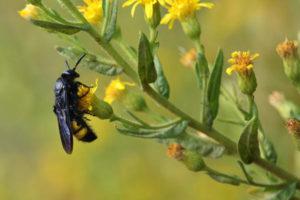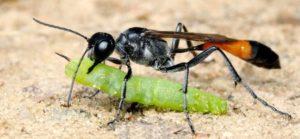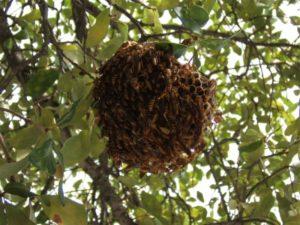What is a wasp: an insect with a controversial character
Wasps are familiar to everyone. And some also suffered from their brutal attacks. But in fact, the insect that bears the name "Wasp" is a large species of stingers.
Content
What wasps look like: photo
general description
Name: Wasps
Title status: indefinedClass: Insects - Insecta
Suborder: Stalk-bellied - Apocrita
 | Habitats: | garden, forest, fields, neighborhood with people |
 | Dangerous for: | bees, people and pets |
 | Description: | stinging insects with a quarrelsome character |
The wasp insect is stinging, with a specific shape of the abdomen and lifestyle features.
To summarize, all representatives of the sting-bellied stingers that are not representatives of bees and ants can be characterized by the concept of a wasp.
Appearance
| dimensions | In the classical sense, the wasp has a small size of about 20 mm. But the sizes vary from 10 mm to 10 cm. |
| Color | Most often, representatives have a yellow-black body, striped. But shades can change. |
| Wings | For the most part, representatives of the species have 4 membranous wings. But there are also completely wingless individuals. |
| Abdomen | It has the shape of a spindle or barrel. |
| Antennae | Located on the head, they are organs of touch, taste buds and even measuring instruments. |
Insect nutrition
Nutritional characteristics depend on the age of the insect and its species. Herbivorous species of wasps love sweet pollen, nectar, juice of fruits and berries. They feed on aphids, sweet secretions that pests leave behind.
Exist predatory species of waspsthat feed on other insects. Their diet includes flies, cockroaches, spiders, beetles, praying mantises and other types of wasps. They teach their offspring from childhood. The wasp catches prey, stings it with poison and paralyzes it. This keeps the food source alive and fresh.
Varieties
There are a large number wasp species. They can differ among themselves in the degree of color, shade and even eating habits. But there are two explicit classifications: solitary and public.
Lifestyle depends on the names
Benefit or harm
Wasps are believed to be pests. Most likely, such a reputation is deserved by painful bites. They can coexist with humans and eat their sweet fruits. Another manifestation of harm is that wasps can attack honey bees.
But in spite of everything, wasps have beneficial features. Some of them eat agricultural pests. They also act as pollinators, although not as well as bees. Recently, there is evidence that poison brazilian wasp used in the treatment of oncology.
Habitat
Different types of wasps are distributed everywhere, from the hot time zone to the Antarctic. They begin their activity at the first rays of the sun, ending with the first cold weather.
They meet in wild nature:
- on the trees;
- in the stagnation of garbage;
- in the fields;
- in hollows;
- in insect burrows.
About people:
- in sheds;
- in attics;
- in heaps of firewood;
- compost pits;
- under the balcony.
If wasp nest only appears - it can be removed without loss. But it is better not to stand in the way of the colony - insects ruthlessly attack in a flock.
Nest features
Paper wasps, which actually are such, because they build their houses from material like paper - competent designers. They build honeycombs gradually, between them there is a distance and piers, so that it is comfortable and warm.
The nest starts from the first row, which is laid out by the uterus. She herself is a designer and a mother for the first generation. As they grow older, each individual takes its place: males and females appear, which perform construction work and feed offspring.
The number of individuals can reach hundreds of thousands in one nest. The hive is filled with life in the spring and by the time it gets colder it finishes all its processes. Insects do not return every year to the same place, but they will gladly build a new nest next to the last year.
Wasp fighting
When the wasps begin to bother people and do harm, an active fight begins with them. But in this case it is necessary to act clearly and reasonably. Methods are chosen according to where the Hymenoptera are localized.
Equally important are personal protective equipment and safety equipment. You will need to protect yourself, cats, dogs and even neighbors. Angry insects can be very dangerous.
Read the complete guide to wasp control here to register:.
Conclusion
Striped black and yellow insects have long been people's neighbors. And it is possible to coexist with them peacefully if the roads do not intersect. In case of danger, it is better for an unprepared person not to fight.
https://youtu.be/7WgDvtICw7s
Previous


